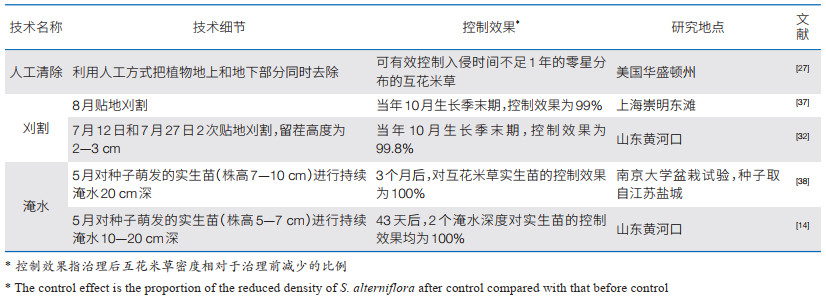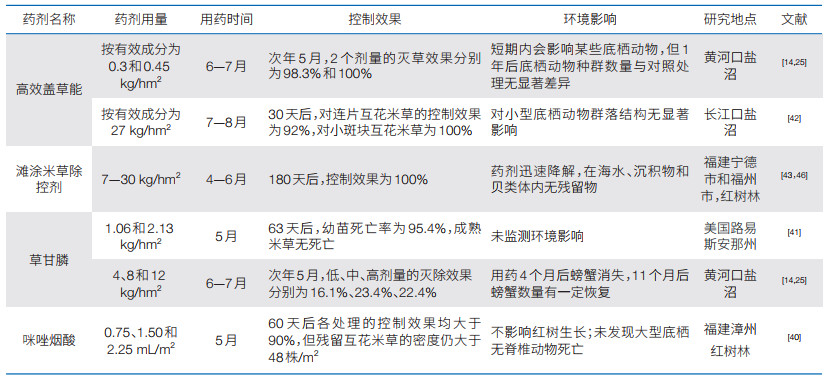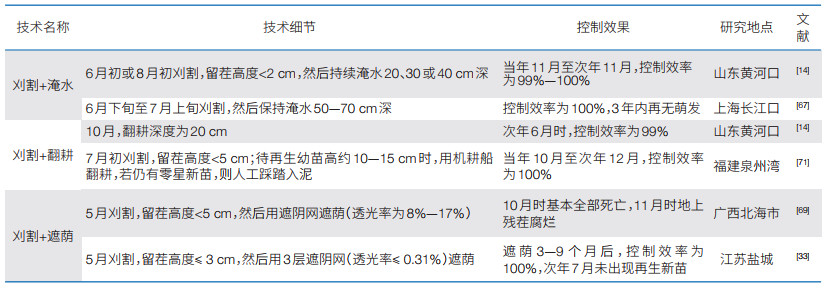2. 中国科学院黄河三角洲滨海湿地生态试验站 东营 257500
2. Yellow River Delta Ecology Research Station of Coastal Wetland, Chinese Academy of Sciences, Dongying 257500, China
互花米草(Spartina alterniflora)是多年生禾本科草本植物,常见于潮间带和河口滩涂;它是全球性入侵物种,入侵了亚洲、欧洲、大洋洲、非洲南部和美国太平洋沿岸等沿海地区[1-3]。1979年,我国从美国大西洋沿岸引入互花米草[4],2020年全国互花米草分布区总面积约519.70 km2[5]。互花米草入侵使滨海湿地生态系统结构与功能遭到破坏,海洋保护地是互花米草重灾区[6]。2003年,原国家环境保护总局联合中国科学院将互花米草列入我国第一批外来入侵物种名单①。2022年12月5日,国家林业和草原局等部门联合发布《互花米草防治专项行动计划(2022—2025年)》,互花米草防治成为我国滨海湿地管理与保护工作的重要内容。
① 国家环境保护总局. 关于发布中国第一批外来入侵物种名单的通知. (2003-01-10). https://www.mee.gov.cn/gkml/zj/wj/200910/t20091022_172155.htm.
基于文献分析和资料调研,本文总结了互花米草入侵的生态危害,不同治理技术的优缺点与适用性;以“互花米草”为关键词,在中国政府采购网、各省市公共资源交易中心网站、地方政府网站及新闻媒体搜集互花米草防治项目的信息并进行梳理,总结我国互花米草防治情况,最后对未来互花米草防治工作提出了建议。
1 互花米草入侵的生态危害互花米草入侵对滨海湿地生态系统结构和功能产生了一系列影响,包括对地形地貌、潮汐水文过程、根际微生物、动植物及其生境,以及碳、氮、磷等元素循环过程的影响[7-10]。互花米草入侵的生态影响是多方面的,最大的正面效应可能是消浪护岸、促淤造陆[11],其负面效应(即生态危害)主要是对生物多样性和生境的威胁,总结为以下3个方面。
(1)通过种间竞争,威胁本土原生植物。互花米草与部分盐沼植物和红树植物具有相同或相近的生态位,但互花米草在盐度较高的地方比本土植物拥有更强的竞争力,其入侵挤占本地植物生存空间[12];另外,互花米草的化感作用可能对本土植物产生抑制作用[13]。互花米草入侵我国后主要与红树林、短叶茳芏、海三棱藨草、芦苇和盐地碱蓬等本土原生植物发生竞争[14-16]。
(2)形成“绿色沙漠”,降低潮间带生物多样性。互花米草密度高、根系发达,其分布区形成“绿色沙漠”,严重威胁大型底栖生物生存,改变潮间带食物网,导致潮间带生物多样性下降[17]。例如,黄河三角洲互花米草分布区的小型螺类、蛤类、蟹类密度降低,经济贝类消失不见[18],大型底栖动物的丰度、生物量和生物多样性随入侵年限的增加先升后降[19]。互花米草入侵也使鸟类食源、栖息生境减少或丧失[20]。
(3)形成“生物堤坝”,影响潮间带水文连通性。高大密集的互花米草在低中潮滩形成一道“生物堤坝”[14],影响海水交换过程,相当于自然的围填海。这种生物堤坝可以堵塞潮沟,降低潮汐浸淹的时长和频率,阻隔潮滩水文连通性,通过改变水盐状况等生境特征而影响本土物种[21, 22]。
2 互花米草防治理念由于互花米草治理难度大、成本高,虽然部分沿海省市已开展了规模化互花米草治理工作,但截至2015年,我国互花米草分布区总面积持续快速增加[23]。快速、有效、安全地控制互花米草的扩散蔓延,是我国滨海湿地保护管理工作面临的巨大挑战。由于山东及其以北地区互花米草面积小且近10年才进入爆发式扩张期[23],2017年以来北方地区互花米草的防范治理才受到关注[14, 24, 25]。
互花米草的生态影响可能因地而异[11]。因此,宜根据互花米草生态危害的大小,对其进行分区有序的防控,并对不同生境的互花米草采用因地制宜的防治技术[26]。本文提出了“生态危害评估—分区有效控制—监测预警”的防治理念(图 1):①生态危害评估,包括对本土动植物及其生境的影响、对航道和泄洪的影响等,按照危害大小进行分区。②分区有效控制,对生态危害大的区域,全面清除互花米草;对生态危害小的区域,及时有效控制互花米草,防止其继续扩散。③监测预警,防范互花米草二次入侵,防止敏感的潜在互花米草分布区遭受入侵;若发现二次入侵或新入侵的互花米草,在幼苗期将其全面清除。
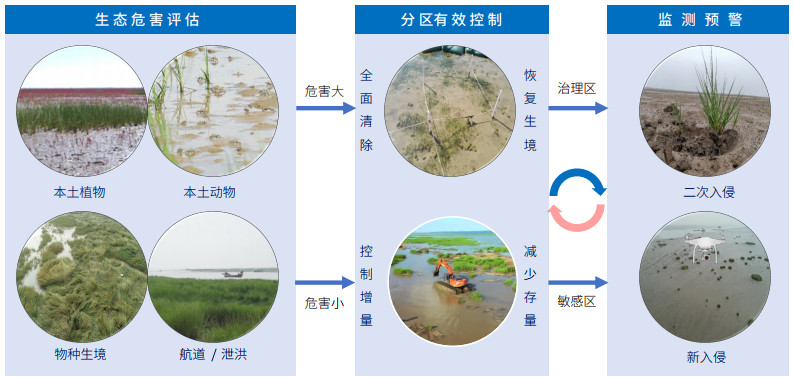
|
| 图 1 互花米草防治理念 Figure 1 Concept of S. alterniflora control |
从代表性和可行性角度考虑,建议调查评估互花米草入侵区域和本土生态系统中的植被、大型底栖动物及鸟类的差别(表 1),并根据差别大小进行危害等级划分——与未入侵的本土生态系统相比,互花米草入侵区域的指标数值越小,则生态危害越大。具体调查评估方法可以参照T/CAOE 20《海岸带生态系统现状调查与评估技术导则》等标准。
根据互花米草生态危害等级评估结果,结合互花米草面积等因素,把互花米草划分为重点治理区、一般治理区、有效控制区3个等级,分区依据和防治目标见表 2。
治理互花米草时,根据生境特征如地形地貌、水文条件等采取因地制宜的技术,既可提高治理效率,又能降低治理成本。对于低潮滩、中潮滩、高潮滩和河道沟渠的互花米草,分别建议采用贴地刈割、刈割+围淹、刈割+翻耕和刈割+围淹等治理技术[26]。
2.3 监测预警监测区域应包括互花米草治理区及其邻近湿地。在治理工程完成后,需要建立巡查预防制度,防范二次入侵。借助无人机、气垫船等设备,每年重点在幼苗期(4—6月)进行巡查,一旦发现互花米草,将其及时清除;由于幼苗的治理难度小、治理成本低,清除完成日期不宜晚于8月。
3 互花米草治理技术互花米草治理技术包括物理治理技术[14, 27, 28]、化学治理技术[25, 27, 29, 30]、生物控制技术和综合治理技术[31]。不同技术各有优缺点和适用性,治理效果也有较大差异[32-34],需因地制宜地采取不同治理技术(图 2)。
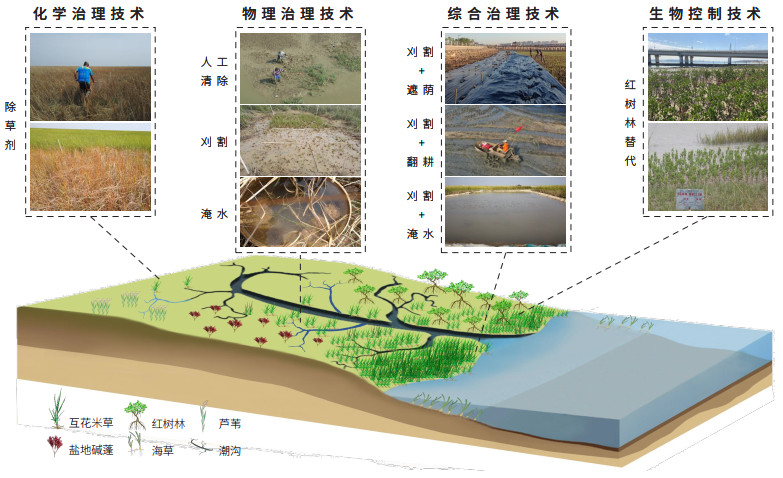
|
| 图 2 互花米草治理技术体系 Figure 2 Control technology system of S. alterniflora |
物理治理技术,如人工清除、刈割等一般不会造成环境污染,短期内对生物可能有一定干扰,但不会对环境和本土生物产生长期、不可逆的影响,互花米草治理完成后本土生物和生境一般可逐渐自然恢复[32]。比较有效的物理治理技术包括人工清除、刈割和淹水等(表 3)。
人工清除,通过人力或借助简单设备清除互花米草。其最大的缺点是效率低,因此不适用于大面积治理,但可用于新入侵或治理后复生零星互花米草的治理[27]。由于互花米草密度高、繁殖能力强,一次治理通常难以清除所有的互花米草(表 3和4)。
刈割,直接割除互花米草地上植株。刈割可削弱植物生长,并降低种子产量[27]。刈割的控制效果受刈割时机、刈割频率和潮汐特征等因素的影响,刈割时机比刈割频率更重要[27, 35]。在孕穗期至扬花期的刈割可获得最佳控制效果,其他时期的刈割效果不好,甚至可能促进互花米草再生[32, 34]。连续多次刈割能取得更好的治理效果[32]。刈割的治理效果还受到潮汐等环境因素的影响,在淹水时间长的区域其效果更佳[36]。
淹水,该方法也被常用于互花米草治理。虽然持续淹水胁迫一般不会使克隆苗和成体互花米草死亡,但对实生苗有致命威胁。水深为10—20 cm时,持续淹水2—3个月可使5—10 cm高的实生苗全部死亡[15, 37]。
物理治理技术在盐沼湿地和红树林湿地均可使用。此类技术可以高效灭除种子萌发的实生苗,但对成体互花米草的治理效果稍差;多次实施人工清除或刈割等物理措施可取得更好的治理效果。
3.2 化学治理技术化学治理技术一般是施用除草剂灭杀互花米草。根据除草剂在植物体内传导能力的差异,将除草剂分成触杀型除草剂和内吸传导型除草剂——前者只能杀死直接接触到药剂的植物组织;后者被植物茎叶吸收后,能被传送到根部,造成植物全株死亡(图 3)。根据选择性差异可将除草剂分成选择性除草剂和广谱灭生性除草剂——后者对植物的伤害无选择性[39]。目前,常被用于治理互花米草的的除草剂包括高效盖草能(haloxyfop-R-methyl)、滩涂米草除控剂、草甘膦(glyphosate)、草铵膦(glufosinate ammonium)、咪唑烟酸(imazapyr)等(表 4)。虽然美国环境保护局许草甘膦和咪唑烟酸在河口环境中使用,但是这2种除草剂灭杀互花米草的效果并不理想[40, 41]。高效盖草能对互花米草的治理效果在不同供试除草剂中是最好的[25, 30],但其短期内对底栖动物有一定毒害[25, 42]。用药剂量和用药时间都会影响高效盖草能灭杀互花米草的效果,每年6—8月是最佳用药时间[14, 25, 42]。
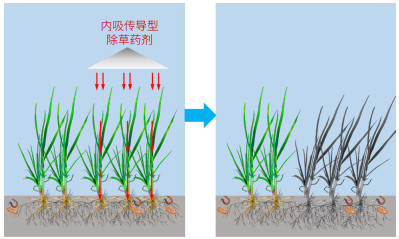
|
| 图 3 互花米草化学治理技术原理 Figure 3 Principle of chemical control technology of S. alterniflora |
化学治理技术简单易行,但可能对环境和本土生物产生负面影响[25]。虽然一些研究发现,使用除草剂治理互花米草时,海水、沉积物和缢蛏等生物体内未检出药剂残留[42-44],但这些研究都是小区研究,施药后短时间内潮汐可能已把残留药剂带入大海中。例如,在黄河口的研究发现,喷施高效盖草能和草甘膦等除草剂后的数月内,螃蟹消失不见[25]。因此,在大面积应用化学技术治理互花米草之前,应对其负面影响做全面、长期的评估[45]。
3.3 生物控制技术生物控制技术包括生物天敌控制技术和生物替代技术。
生物天敌控制技术,指利用寄主范围较为专一的植食性动物或病原微生物,通过直接取食或致病等方式控制有害植物。目前,利用生物天敌控制互花米草的研究非常少,研究人员尝试用玉黍螺(Littoraria irrorata)、麦角菌(Ciavieps purpurea)和稻飞虱(Prokelisia marginata)控制互花米草,但效果均不佳[47-49]。
生物替代技术,是用竞争力强的本地植物取代外来入侵植物的一种生态学防治技术。生物替代技术在红树林地区表现出较好效果[15],但在盐沼地区效果不佳[34]。使用该类技术时一般需要先利用物理或化学方法清除互花米草,然后种植本土植被,以巩固治理效果并恢复本土生态系统[50, 51]。因此,生物替代技术也属于综合治理技术——但由于其强调在治理互花米草的同时修复本土植被,研究人员通常把生物替代技术单列为一类治理技术(表 5)。目前研究较多的是利用芦苇和红树植物对互花米草进行生物替代[31]。虽然芦苇比互花米草有更好的耐淹能力[52],但其耐盐性能弱于互花米草[53, 54],因此芦苇无法成功替代互花米草[34]。生物替代技术的研究与应用更多地出现在红树林地区。用红树替代互花米草的原理与遮荫方法相似,当林分郁闭度超过0.6时,林下互花米草由于光照强度过弱而停止生长并逐渐消亡[55, 56]。用红树植物替代互花米草的技术措施包括“人工刈割+种植红树”[51]、“刈割+高程抬高+种植红树”[15]、“刈割+水淹+种植红树”[50]和“刈割+翻耕+覆膜+种植红树”[57]等。常用的红树植物包括秋茄(Kandelia obovata)、无瓣海桑(Sonneratia apetala)和海桑(Sonneratia caseolaris)等。其中,秋茄是我国最耐寒的红树植物,人工引种的北界是温州乐清[58]。在浙江鳌江口和福建漳江口,利用秋茄替代互花米草取得了很好的效果[15, 51],但在广东珠海淇澳岛的效果不佳[59],这可能和管护有关——在秋茄幼苗种植初期,应定期刈割去除互花米草[60]。另外,高密度种植有利于秋茄占据生态位空间[15]。无瓣海桑也是外来物种,在广西北海等地表现出了一定的入侵性[61-63],因此应慎用其替代互花米草。海桑在我国仅天然分布于海南,目前已广泛引种于广东、广西[64]。应用海桑替代互花米草的研究很少,在广东珠海淇澳岛的研究发现,海桑替代互花米草的效果不佳[59, 65]。
总体而言,生物替代技术难以用于盐沼湿地,但在红树林湿地互花米草的防治中得到了较多应用,未来应加强利用本土红树替代治理互花米草的技术研究和推广应用。
3.4 综合治理技术综合治理技术是指把不同治理技术配合使用,通常可以取得更好的治理效果,因此研究与应用最为广泛[14, 33, 66]。高效综合治理技术包括“刈割+淹水”“刈割+翻耕”和“刈割+遮荫”等(表 6),并且前述生物替代技术也属于综合技术。
“刈割+淹水”,既能控制互花米草的生长和有性繁殖,还会使刈割后的根茬窒息死亡[28]。“刈割+淹水”的治理效果因时间而异,6—8月是适宜的治理时机,但6月比8月更佳[14, 67],为了保障治理效果、减少筑堤难度和成本,留茬高度不宜超过10 cm[14]。
“刈割+翻耕”,能同时控制互花米草的有性繁殖和无性繁殖。多遍翻耕可有效提高治理效果,但不同翻耕深度对治理效果无显著影响[37]。“刈割+翻耕”的治理效果在北方可能优于南方:10月中旬即生长季末期的“刈割+翻耕”对黄河口互花米草无性繁殖的控制效率可达99.4%[14];但在长江口,2—3月的“刈割+翻耕”对互花米草无性繁殖的控制效率为30%—85%[37]。
“刈割+遮荫”,通过抑制光合作用除治互花米草,通常先刈割并移走互花米草,然后覆盖遮荫材料。低于15%的透光率可能关键技术指标,透光率越低,效果越好;当遮荫透光率小于0.3%时,遮荫2—3个月可完全杀死互花米草[33, 68, 69]。不同月份实施刈割+遮荫都有很好的治理效果,但5—7月优于8—11月[70]。
综合治理技术通常比单一治理技术的效果更好,在盐沼湿地和红树林湿地,都可以采用综合治理技术控制互花米草。
4 我国互花米草防治现状2012年1月—2023年6月初,我国共实施规模化互花米草防治相关项目188项,总投资约为23.81亿元(表 7)。其中,治理类项目的数量和投资额度均最多,其次是治理恢复类即治理互花米草并恢复本地植被的项目。

|
2012—2014年,上海市、福建省和广东省便开始了规模化互花米草治理,其他沿海省份多数从2017年开始规模化互花米草防治工作(图 4)。2012—2019年,我国实施互花米草防治项目26个;2020年开始,互花米草防治项目进入快速增长期。上海市、山东省、福建省和江苏省用于互花米草防治的资金远高于其他沿海省份(市),分别为12.24亿元、4.20亿元、3.31亿元和2.58亿元(图 5)。
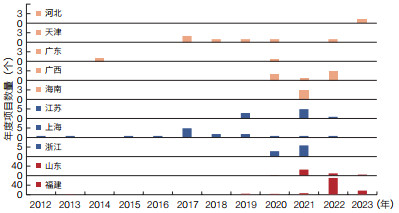
|
| 图 4 我国互花米草防治项目数量 Figure 4 Annual number of S. alterniflora control projects in China 不同省份的量程不同,以便更好地展示数据 The individually displayed chart is to better present the data for each province |
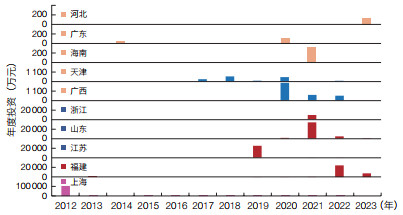
|
| 图 5 我国互花米草防治项目年投资额度(万元) Figure 5 Annual project investment amount of S. alterniflora control in China (RMB 10000) 不同省份的量程不同,以便更好地展示数据 The individually displayed chart is to better present the data for each province |
涉及互花米草治理成本的研究文献很少。美国华盛顿州用化学方法治理互花米草的成本约为124600元/千米海岸线(17500美元/千米,按7.12倍汇率换算)[29];我国黄河口的化学治理成本和“刈割+淹水”治理成本分别为7920和29325元/公顷[14];南非的化学治理成本为55536元/公顷(7800美元/公顷,按7.12倍汇率换算)[72]。
规模化治理的成本高于文献报道。根据54个公开招标的治理项目,互花米草治理成本平均值为44370元/公顷,中位数为29700元/公顷(图 6)。化学治理方法的治理成本一般低于物理治理方法,但天津市采用化学方法的成本也高达28653元/公顷。各地互花米草治理成本差异很大,可能与互花米草分布状况、环境差异和所用技术不同有关。
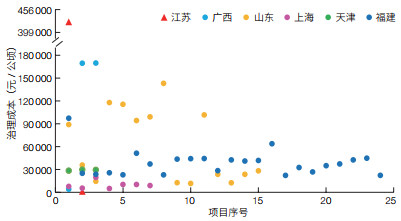
|
| 图 6 我国互花米草治理成本 Figure 6 Cost of controlling S. alterniflora in China 横轴下方数字为按立项先后顺序的各省份项目序号 The numbers below the horizontal axis represent the project serial numbers according to the order of project approval in each province |
互花米草防治长效机制包括预警监测和治理成果巩固。①建立高分辨率卫星遥感、无人机航拍和现场踏勘等技术手段相结合的预警监测体系。在治理工程结束后,定期监测,及时发现并全面清除遗漏复生或二次入侵的互花米草。②本土植被恢复和滩涂利用是巩固互花米草治理成果的有效手段。在适宜区域,可在互花米草治理后种植速生红树或开展滩涂底播养殖。
5.2 产学研结合,优化综合治理技术虽然科研人员已经研发出多种高效的综合治理技术,但这些技术多数是基于小区试验研究,在大规模治理互花米草时,可能遇到很多新问题。因此,应鼓励科研机构和企业共同实施规模化互花米草治理工程,在实践中进一步优化现有综合治理技术,研发新技术,并有效保障技术落地,从而提高互花米草治理效率并降低治理成本。
5.3 加强机械设备研发,保障治理技术落地复杂多变的地理环境给互花米草治理带来很大难度,不同地理环境中需要不同的治理技术和配套的专业设备,专业机械设备的缺乏在很大程度上限制了治理技术的有效发挥。因此,需要根据互花米草治理技术特征、地理环境和地质条件等因素,研发专业机械设备,从而提高治理效率,降低治理成本,保障互花米草治理技术的落地性。
5.4 加强治理效果与环境影响评估任何一种互花米草治理方法都会对滨海湿地生态系统带来不同程度的扰动。在治理过程中,需定期监测评估治理效果及其影响,为实现对治理工程的全生命周期管理提供依据和指导。另外,可能还需要评估互花米草治理后海岸侵蚀、风暴潮等海洋灾害的发生概率或速率,以便为海岸带保护提供理论与技术支持。
| [1] |
Chung C H. Forty years of ecological engineering with Spartina plantations in China. Ecological Engineering, 2006, 27(1): 49-57. DOI:10.1016/j.ecoleng.2005.09.012 |
| [2] |
Adams J, Wyk E, Riddin T. First record of Spartina alterniflora in southern Africa indicates adaptive potential of this saline grass. Biological Invasions, 2016, 18(8): 2153-2158. DOI:10.1007/s10530-015-0957-5 |
| [3] |
Taylor C M, Hastings A. Finding optimal control strategies for invasive species: A density-structured model for Spartina alterniflora. Journal of Applied Ecology, 2004, 41(6): 1049-1057. DOI:10.1111/j.0021-8901.2004.00979.x |
| [4] |
徐国万, 卓荣宗, 曹豪, 等. 互花米草生物量年动态及其与滩涂生境的关系. 植物生态学与地植物学学报, 1989, 13(3): 230-235. Xu G W, Zhuo R Z, Cao H, et al. Annual changes of biomass of Spartina alterniflora and the relationships between biomass and tidal land habits. Chinese Journal of Plant Ecology, 1989, 13(3): 230-235. (in Chinese) |
| [5] |
Li H Y, Mao D H, Wang Z M, et al. Invasion of Spartina alterniflora in the coastal zone of mainland China: Control achievements from 2015 to 2020 towards the Sustainable Development Goals. Journal of Environmental Management, 2022, 323: 116242. DOI:10.1016/j.jenvman.2022.116242 |
| [6] |
于彩芬, 许道艳, 刘长安, 等. 海洋保护地内施用除草剂防治互花米草的监管研究. 环境生态学, 2021, 3(9): 38-40. Yu C F, Xu D Y, Liu C A, et al. On supervision policy of spraying herbicides to control Spartina alterniflora in marine protected area. Marine Environmental Ecology, 2021, 3(9): 38-40. (in Chinese) |
| [7] |
Nie M, Liu W W, Pennings S C, et al. Lessons from the invasion of Spartina alterniflora in coastal China. Ecology, 2023, 104: e3874. DOI:10.1002/ecy.3874 |
| [8] |
Yu C F, Cao J C, Du W, et al. Changes in the population and functional profile of bacteria and fungi in the rhizosphere of Suaeda salsa is driven by invasion of Spartina alterniflora. Ecological Indicators, 2022, 144: 109516. DOI:10.1016/j.ecolind.2022.109516 |
| [9] |
Peng X, Yu X Q, Zhai X Y, et al. Spatiotemporal patterns of different forms of nitrogen in a coastal mangrove wetland invaded by Spartina alterniflora. Estuarine, Coastal and Shelf Science, 2023, 280: 108167. DOI:10.1016/j.ecss.2022.108167 |
| [10] |
Sun K K, Yu W S, Jiang J J, et al. Mismatches between the resources for adult herbivores and their offspring suggest invasive Spartina alterniflora is an ecological trap. Journal of Ecology, 2020, 108(2): 719-732. DOI:10.1111/1365-2745.13277 |
| [11] |
Zhang M, Schwarz C, Lin W P, et al. A new perspective on the impacts of Spartina alterniflora invasion on Chinese wetlands in the context of climate change: A case study of the Jiuduansha Shoals, Yangtze Estuary. Science of the Total Environment, 2023, 868: 161477. DOI:10.1016/j.scitotenv.2023.161477 |
| [12] |
Gu J L, Wu J P. Blue carbon effects of mangrove restoration in subtropics where Spartina alterniflora invaded. Ecological Engineering, 2023, 186: 106822. DOI:10.1016/j.ecoleng.2022.106822 |
| [13] |
陈依婷, 乔文慧, 曾从盛. 闽江河口入侵植物互花米草对短叶茳芏的化感效应. 应用海洋学学报, 2018, 37(1): 45-52. Chen Y T, Qiao W H, Zeng C S. Allelopathic effect of exotic Spartina alterniflora on native Cyperus malaccensis in Minjiang Estuary. Journal of Applied Oceanography, 2018, 37(1): 45-52. (in Chinese) |
| [14] |
Xie B H, Han G X, Qiao P Y, et al. Effects of mechanical and chemical control on invasive Spartina alterniflora in the Yellow River Delta, China. PeerJ, 2019, 7: e7655. DOI:10.7717/peerj.7655 |
| [15] |
冯建祥, 宁存鑫, 朱小山, 等. 福建漳江口本土红树植物秋茄替代互花米草生态修复效果定量评价. 海洋与湖沼, 2017, 48(2): 266-275. Feng J X, Ning C X, Zhu X S, et al. Ecological restoration by native-invasive species replacement for mangrove wetlands in Zhangjiang River Estuary, Fujian. Oceanologia et Limnologia Sinica, 2017, 48(2): 266-275. (in Chinese) |
| [16] |
解雪峰, 孙晓敏, 吴涛, 等. 互花米草入侵对滨海湿地生态系统的影响研究进展. 应用生态学报, 2020, 31(6): 2119-2128. Xie X F, Sun X M, Wu T, et al. Impacts of Spartina alterniflora invasion on coastal wetland ecosystem: Advances and prospects. Chinese Journal of Applied Ecology, 2020, 31(6): 2119-2128. (in Chinese) |
| [17] |
冯建祥, 黄茜, 陈卉, 等. 互花米草入侵对盐沼和红树林滨海湿地底栖动物群落的影响. 生态学杂志, 2018, 37(3): 943-951. Feng J X, Huang Q, Chen H, et al. Effects of Spartina alterniflora invasion on benthic faunal community in saltmarsh and mangrove wetland. Chinese Journal of Ecology, 2018, 37(3): 943-951. (in Chinese) |
| [18] |
申保忠, 田家怡, 于祥, 等. 黄河三角洲米草入侵对滩涂底栖动物多样性的影响. 海洋科学进展, 2009, 27(3): 384-392. Shen B Z, Tian J Y, Yu X, et al. Effects on Zoobenthos diversity by Spartina spp.invasion in tidal flat of Yellow River delta. Advances in Marine Science, 2009, 27(3): 384-392. (in Chinese) |
| [19] |
Jiang S Y, Zhang C X, Chen L L, et al. Effects of smooth cordgrass Spartina alterniflora invasion on macrobenthic fauna in the Yellow River Delta. Wetlands, 2022, 42(1): 1-12. DOI:10.1007/s13157-021-01519-1 |
| [20] |
陈潘, 张燕, 朱晓静, 等. 互花米草入侵对鸟类的生态影响. 生态学报, 2019, 39(7): 2282-2290. Chen P, Zhang Y, Zhu X J, et al. Ecological effects of invasion by the smooth cordgrass Spartina alterniflora on birds. Acta Ecologica Sinica, 2019, 39(7): 2282-2290. (in Chinese) |
| [21] |
于冬雪, 韩广轩, 王晓杰, 等. 互花米草入侵对黄河口潮沟形态特征和植物群落分布的影响. 生态学杂志, 2022, 41(1): 42-49. Yu D X, Han G X, Wang X J, et al. Effects of Spartina alterniflora invasion on morphological characteristics of tidal creeks and plant community distribution in the Yellow River Estuary. Chinese Journal of Ecology, 2022, 41(1): 42-49. (in Chinese) |
| [22] |
Wang B, Zhang K, Liu Q X, et al. Long-distance facilitation of coastal ecosystem structure and resilience. Proceedings of the National Academy of Sciences of the United States of America, 2022, 119(28): e2123274119. |
| [23] |
Zhang D, Hu Y, Liu M, et al. Introduction and spread of an exotic plant, Spartina alterniflora, along coastal marshes of China. Wetlands, 2017, 37(6): 1181-1193. DOI:10.1007/s13157-017-0950-0 |
| [24] |
于彩芬, 许道艳, 邢庆会, 等. 浅谈环渤海地区互花米草(Spartina alterniflora) 防治建议. 海洋环境科学, 2021, 40(6): 903-907. Yu C F, Xu D Y, Xing Q H, et al. Discussion on prevention and control of invasive Spartina alterniflora in Bohai rim region. Marine Environmental Science, 2021, 40(6): 903-907. (in Chinese) |
| [25] |
乔沛阳, 王安东, 谢宝华, 等. 除草剂对黄河三角洲入侵植物互花米草的影响. 生态学报, 2019, 39(15): 5627-5634. Qiao P Y, Wang A D, Xie B H, et al. Effects of herbicides on invasive Spartina alterniflora in the Yellow River Delta. Acta Ecologica Sinica, 2019, 39(15): 5627-5634. (in Chinese) |
| [26] |
谢宝华, 闫振宁, 张树岩, 等. 不同潮滩生境互花米草的植被性状与治理技术. 环境工程, 2023, 41(6): 1-8. Xie B H, Yan Z N, Zhang S Y, et al. Vegetation characteristics and control techniques of Spartina alterniflora in different tidal flat habitats. Environmental Engineering, 2023, 41(6): 1-8. (in Chinese) |
| [27] |
Hedge P, Kriwoken L K, Patten K. A review of Spartina management in Washington State, US. Journal of Aquatic Plant Management, 2003, 41: 82-90. |
| [28] |
谢宝华, 王安东, 赵亚杰, 等. 刈割加淹水对互花米草萌发和幼苗生长的影响. 生态学杂志, 2018, 37(2): 417-423. Xie B H, Wang A D, Zhao Y J, et al. Effects of mowing plus waterlogging on germination and seedling growth of Spartina alterniflora. Chinese Journal of Ecology, 2018, 37(2): 417-423. (in Chinese) |
| [29] |
Patten K, O'Casey C, Metzger C. Large-scale chemical control of smooth cordgrass (Spartina alterniflora) in Willapa Bay, WA: Towards eradication and ecological restoration. Invasive Plant Science and Management, 2017, 10(3): 284-292. DOI:10.1017/inp.2017.25 |
| [30] |
Wang Y T, He Y L, Qiao P Y, et al. Control effects of different herbicides on Spartina alterniflora. Ecological Indicators, 2023, 154: 110824. DOI:10.1016/j.ecolind.2023.110824 |
| [31] |
谢宝华, 韩广轩. 外来入侵种互花米草防治研究进展. 应用生态学报, 2018, 29(10): 3464-3476. Xie B H, Han G X. Control of invasive Spartina alterniflora: A review. Chinese Journal of Applied Ecology, 2018, 29(10): 3464-3476. (in Chinese) |
| [32] |
乔沛阳. 黄河三角洲入侵植物互花米草物理、化学防治研究. 呼和浩特: 内蒙古大学, 2019. Qiao P Y. Study on mechanical and chemical control of invasive plant Spartina alterniflora in Yellow River Delta. Hohhot: Inner Mongolia University, 2019. (in Chinese) |
| [33] |
李飞飞, 高珂晓, 朱金方, 等. 综合物理防控技术对盐城大丰港互花米草的控制效果. 生态学报, 2021, 41(24): 9637-9644. Li F F, Gao K X, Zhu J F, et al. Effect of comprehensive physical control technologies on Spartina alterniflora in Dafeng Port, Yancheng. Acta Ecologica Sinica, 2021, 41(24): 9637-9644. (in Chinese) |
| [34] |
平原, 张利权. 物理措施控制互花米草的长期效果研究. 海洋环境科学, 2010, 29(1): 32-35. Ping Y, Zhang L Q. Study on long-term effects of physical control measures on Spartina alterniflora. Marine Environmental Science, 2010, 29(1): 32-35. (in Chinese) |
| [35] |
Gao Y, Tang L, Wang J Q, et al. Clipping at early florescence is more efficient for controlling the invasive plant Spartina alterniflora. Ecological Research, 2009, 24(5): 1033-1041. |
| [36] |
Tang L, Gao Y, Wang C H, et al. Habitat heterogeneity influences restoration efficacy: Implications of a habitatspecific management regime for an invaded marsh. Estuarine, Coastal and Shelf Science, 2013, 125: 20-26. |
| [37] |
李贺鹏, 张利权. 外来植物互花米草的物理控制实验研究. 华东师范大学学报(自然科学版), 2007, (6): 44-55. Li H P, Zhang L Q. Experimental study on physical controls of an exotic plant Spartina alterniflora in Shanghai. Journal of East China Normal University (Natural Science), 2007, (6): 44-55. (in Chinese) |
| [38] |
陈正勇, 王国祥, 刘金娥, 等. 淹水调控对互花米草生长的影响. 环境科学研究, 2011, 24(9): 1003-1007. Chen Z Y, Wang G X, Liu J E, et al. Effects of waterlogging regulation on growth of Spartina alterniflora. Research of Environmental Sciences, 2011, 24(9): 1003-1007. (in Chinese) |
| [39] |
叶贵标. 除草剂作用机理分类法及其应用. 农药科学与管理, 1999, 20(1): 32-35. Ye G B. Classification methold of herbididels according to mode of action ant its application. Pesticide Science and Administration, 1999, 20(1): 32-35. (in Chinese) |
| [40] |
莫雪, 吴博, 刘佳凯, 等. 施用咪唑烟酸除草剂去除漳江口红树林中互花米草的短期实验. 湿地科学, 2022, 20(2): 277-284. Mo X, Wu B, Liu J K, et al. Short term experiment on application of imazapyr herbicide to remove Spartina alterniflora in mangrove at Zhangjiang Estuary. Wetland Science, 2022, 20(2): 277-284. (in Chinese) |
| [41] |
Knott C A, Webster E P, Nabukalu P. Control of smooth cordgrass (Spartina alterniflora) seedlings with four herbicides. Journal of Aquatic Plant Management, 2013, 51: 132-135. |
| [42] |
Zhao Z, Xu Y, Yuan L, et al. Emergency control of Spartina alterniflora re-invasion with a chemical method in Chongming Dongtan, China. Water Science and Engineering, 2020, 13(1): 24-33. |
| [43] |
许珠华. 福建治理互花米草试验研究. 海洋环境科学, 2010, 29(5): 767-769. Xu Z H. Experimental study on treatment of Spartina alterniflora in Fujian. Marine Environmental Science, 2010, 29(5): 767-769. (in Chinese) |
| [44] |
Liang Q Y, Yan Z Z, Li X Z. Influence of the herbicide haloxyfop-R-methyl on bacterial diversity in rhizosphere soil of Spartina alterniflora. Ecotoxicology and Environmental Safety, 2020, 194: 110366. |
| [45] |
秦璐, 宋秀凯, 刘丽娟, 等. 高效氟吡甲禾灵对海洋生物的急性毒性与水质基准推导. 环境科学研究, 2022, 35(6): 1509-1518. Qin L, Song X K, Liu L J, et al. Acute toxicity of haloxyfopP-methyl to marine species and its seawater quality criteria. Research of Environmental Sciences, 2022, 35(6): 1509-1518. (in Chinese) |
| [46] |
郭乾友. 滩涂互花米草除治技术研究. 防护林科技, 2011, (2): 3-5. Guo Q Y. Control for Spartina alterniflora in beach. Protection Forest Science and Technology, 2011, (2): 3-5. (in Chinese) |
| [47] |
Fisher A J, DiTomaso J M, Gordon T R. Intraspecific groups of Claviceps purpurea associated with grass species in Willapa Bay, Washington, and the prospects for biological control of invasive Spartina alterniflora. Biological Control, 2005, 34(2): 170-179. |
| [48] |
Silliman B R, Zieman J C. Top-down control of Spartina alterniflora production by periwinkle grazing in a Virginia salt marsh. Ecology, 2001, 82(10): 2830-2845. |
| [49] |
Wu M Y, Hacker S, Ayres D, et al. Potential of Prokelisia spp.as biological control agents of English cordgrass, Spartina anglica. Biological Control, 1999, 16(3): 267-273. |
| [50] |
李旭伟, 仝川, 雍石泉, 等. 刈割+水淹治理互花米草技术对湿地土壤性状及其有机碳含量的影响. 湿地科学与管理, 2011, 7(4): 44-47. Li X W, Tong C, Yong S Q, et al. Effect of controlling measures of Spartina alterniflora on soil properties and contents of organic carbon. Wetland Science & Management, 2011, 7(4): 44-47. (in Chinese) |
| [51] |
林秋莲, 顾肖璇, 陈昕韡, 等. 红树植物秋茄替代互花米草的生态修复评估——以浙江温州为例. 生态学杂志, 2020, 39(6): 1761-1768. Lin Q L, Gu X X, Chen X W, et al. Coastal wetland restoration based on mangrove Kandelia obovata substitution controlling Spartina alterniflora invasion: A case study of Aojiang Estuary in Zhejiang Province. Chinese Journal of Ecology, 2020, 39(6): 1761-1768. (in Chinese) |
| [52] |
古志钦, 张利权, 袁琳. 互花米草与芦苇光合色素含量对淹水措施的响应. 应用生态学报, 2009, 20(10): 2365-2369. Gu Z Q, Zhang L Q, Yuan L. Responses of photosynthetic pigments of Spartina alterniflora and Phragmites australis to durative waterlogging. Chinese Journal of Applied Ecology, 2009, 20(10): 2365-2369. (in Chinese) |
| [53] |
谷东起, 付军, 闫文文, 等. 盐城滨海湿地退化评估及分区诊断. 湿地科学, 2012, 10(1): 1-7. Gu D Q, Fu J, Yan W W, et al. Evaluation of coastal wetlands degradation in Yancheng city and zonal diagnosis. Wetland Science, 2012, 10(1): 1-7. (in Chinese) |
| [54] |
刘展航, 张树岩, 侯玉平, 等. 互花米草入侵对黄河口湿地土壤碳氮磷及其生态化学计量特征的影响. 生态环境学报, 2022, 31(7): 1360-1369. Liu Z H, Zhang S Y, Hou Y P, et al. Effects of Spartina alterniflora invasion on soil carbon, nitrogen, phosphorus and their ecostoichiometric characteristics in the Yellow River Estuary wetlands. Ecology and Environmental Sciences, 2022, 31(7): 1360-1369. (in Chinese) |
| [55] |
杨雄邦, 田广红, 廖宝文, 等. 无瓣海桑大战互花米草——运用植物更替措施控制互花米草的实践. 湿地科学与管理, 2010, 6(4): 33. Yang X B, Tian G H, Liao B W, et al. Sonneratia apetala vs Spartina alterniflora-Practice of controlling Spartina alterniflora with plant replacement measures. Wetland Science & Management, 2010, 6(4): 33. (in Chinese) |
| [56] |
陈振忠. 闽南沿海滩涂互花米草生物替代治理技术研究. 安徽农学通报, 2016, 22(14): 117-119. Chen Z Z. Study on biological substitution treatment technology of Spartina alterniflora in coastal beaches of southern Fujian. Anhui Agricultural Science Bulletin, 2016, 22(14): 117-119. (in Chinese) |
| [57] |
赵秋毅. 泉州湾红树植物秋茄治理互花米草的生理生态效应研究. 厦门: 集美大学, 2019. Zhao Q Y. Study on Physiological and Ecological Effects of Controlling Sporobolus alterniflorus by Kandelia obovata in Quanzhou Bay. Xiameng: Jimei University, 2019. (in Chinese) |
| [58] |
林鹏. 中国红树林研究进展. 厦门大学学报(自然科学版), 2001, 40(2): 592-603. Lin P. A review on the mangrove research in China. Journal of Xiamen University (Natural Science), 2001, 40(2): 592-603. (in Chinese) |
| [59] |
陈玉军, 郑松发, 廖宝文, 等. 红树植物控制互花米草技术. 林业实用技术, 2009, (12): 35-36. Chen Y J, Zheng S F, Liao B W, et al. Techniques of controlling Spartina alterniflora by mangrove plants. Practical Forestry Technology, 2009, (12): 35-36. (in Chinese) |
| [60] |
Zhang Y H, Huang G M, Wang W Q, et al. Interactions between mangroves and exotic Spartina in an anthropogenically disturbed estuary in Southern China. Ecology, 2012, 93(3): 588-597. |
| [61] |
邓必玉, 吴玲巧, 秦旭东, 等. 广西红树林主要外来植物现状及防控对策研究. 林业调查规划, 2020, 45(4): 54-60. Deng B Y, Wu L Q, Qin X D, et al. Current situation and control measures of exotic plants in mangrove forest of Guangxi. Forest Inventory and Planning, 2020, 45(4): 54-60. (in Chinese) |
| [62] |
黄冠闽. 漳江口红树林保护区外来红树植物无瓣海桑的防控. 防护林科技, 2018, (6): 58-59. Huang G M. Prevention and control of non-petalous Sonneratia officinalis in the Zhangjiang River Estuary Mangrove Reserve. Protection Forest Science and Technology, 2018, (6): 58-59. (in Chinese) |
| [63] |
Peng D, Chen L Z, Pennings S C, et al. Using a marsh organ to predict future plant communities in a Chinese Estuary invaded by an exotic grass and mangrove. Limnology and Oceanography, 2018, 63(6): 2595-2605. |
| [64] |
李海生, 陈桂珠. 海南岛红树植物海桑遗传多样性的ISSR分析. 生态学报, 2004, 24(8): 1657-1663. Li H S, Chen G Z. Genetic diversity of mangrove plant Sonneratia caseolaris in Hainan Island based on ISSR analysis. Acta Ecologica Sinica, 2004, 24(8): 1657-1663. (in Chinese) |
| [65] |
Zhou T, Liu S C, Feng Z L, et al. Use of exotic plants to control Spartina alterniflora invasion and promote mangrove restoration. Scientific Reports, 2015, 5: 12980. |
| [66] |
Wang S Y, Martin P A, Hao Y, et al. A global synthesis of the effectiveness and ecological impacts of management interventions for Spartina species. Frontiers of Environmental Science & Engineering, 2023, 17(11): 1-10. |
| [67] |
盛强, 黄铭垚, 汤臣栋, 等. 不同互花米草治理措施对植物与大型底栖动物的影响. 水生生物学报, 2014, 38(2): 279-290. Sheng Q, Huang M Y, Tang C D, et al. Effects of different eradication measures for controlling Spartina alterniflora on plants and macrobenthic invertebrates. Acta Hydrobiologica Sinica, 2014, 38(2): 279-290. (in Chinese) |
| [68] |
赵相健, 李俊生, 柳晓燕, 等. 刈割加遮荫对互花米草生长和存活的影响. 广西植物, 2017, 37(3): 303-307. Zhao X J, Li J S, Liu X Y, et al. Combined effects of mowing and shading on growth and survival of Spartina alterniflora. Guihaia, 2017, 37(3): 303-307. (in Chinese) |
| [69] |
赵相健, 柳晓燕, 宫璐, 等. 刈割加遮荫综合治理互花米草(Spartina alterniflora). 生态学杂志, 2014, 33(10): 2714-2719. Zhao X J, Liu X Y, Gong L, et al. Control of Spartina alterniflora by integrated technique of mowing plus shading. Chinese Journal of Ecology, 2014, 33(10): 2714-2719. (in Chinese) |
| [70] |
Zhao C Y, Li J S, Zhao X J. Mowing plus shading as an effective method to control the invasive plant Spartina alterniflora. Flora, 2019, 257: 151408. |
| [71] |
谭芳林. 机械法治理互花米草效果及其对滩涂土壤性状影响研究. 湿地科学, 2008, 6(4): 526-530. Tan F L. Effect of the method combining cutting with machine boat on controlling Spartina alterniflora and its impact on wetland soil characteristics. Wetland Science, 2008, 6(4): 526-530. (in Chinese) |
| [72] |
Riddin T, van Wyk E, Adams J. The rise and fall of an invasive estuarine grass. South African Journal of Botany, 2016, 107: 74-79. |







